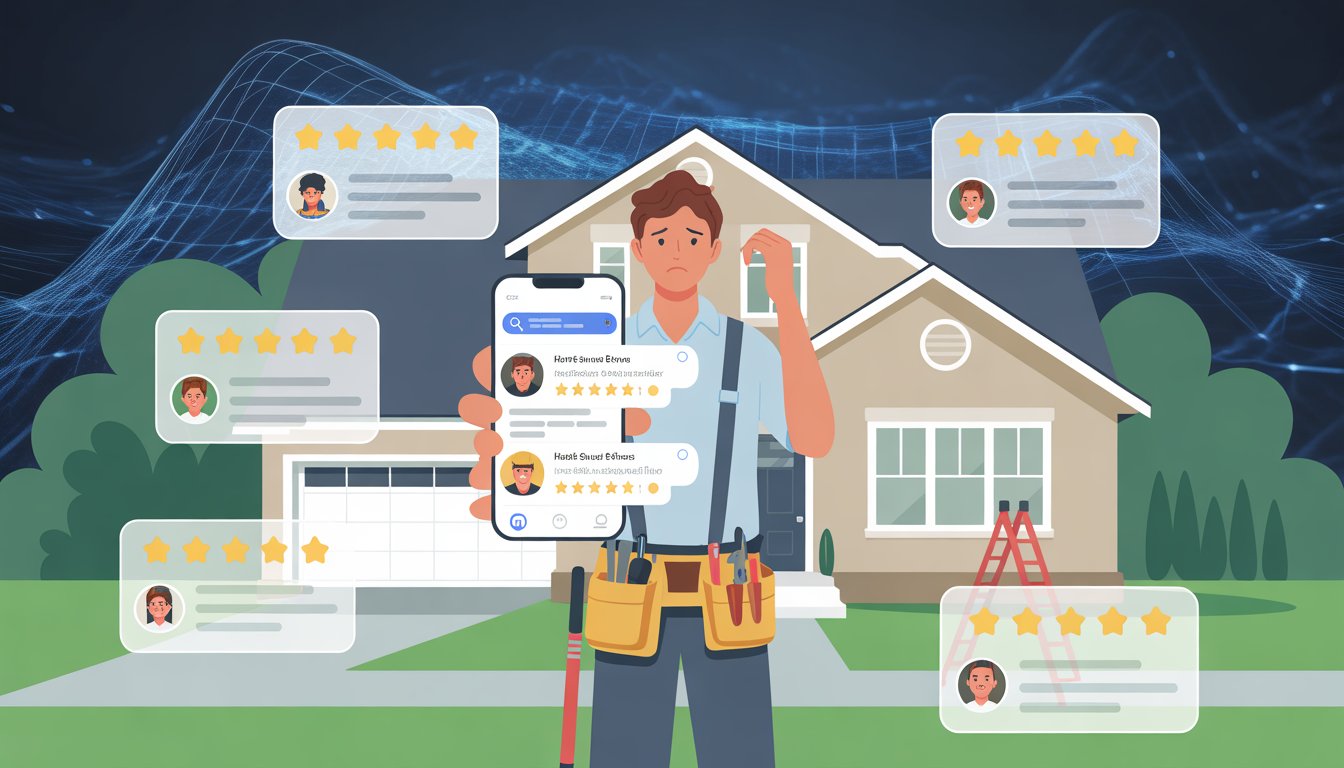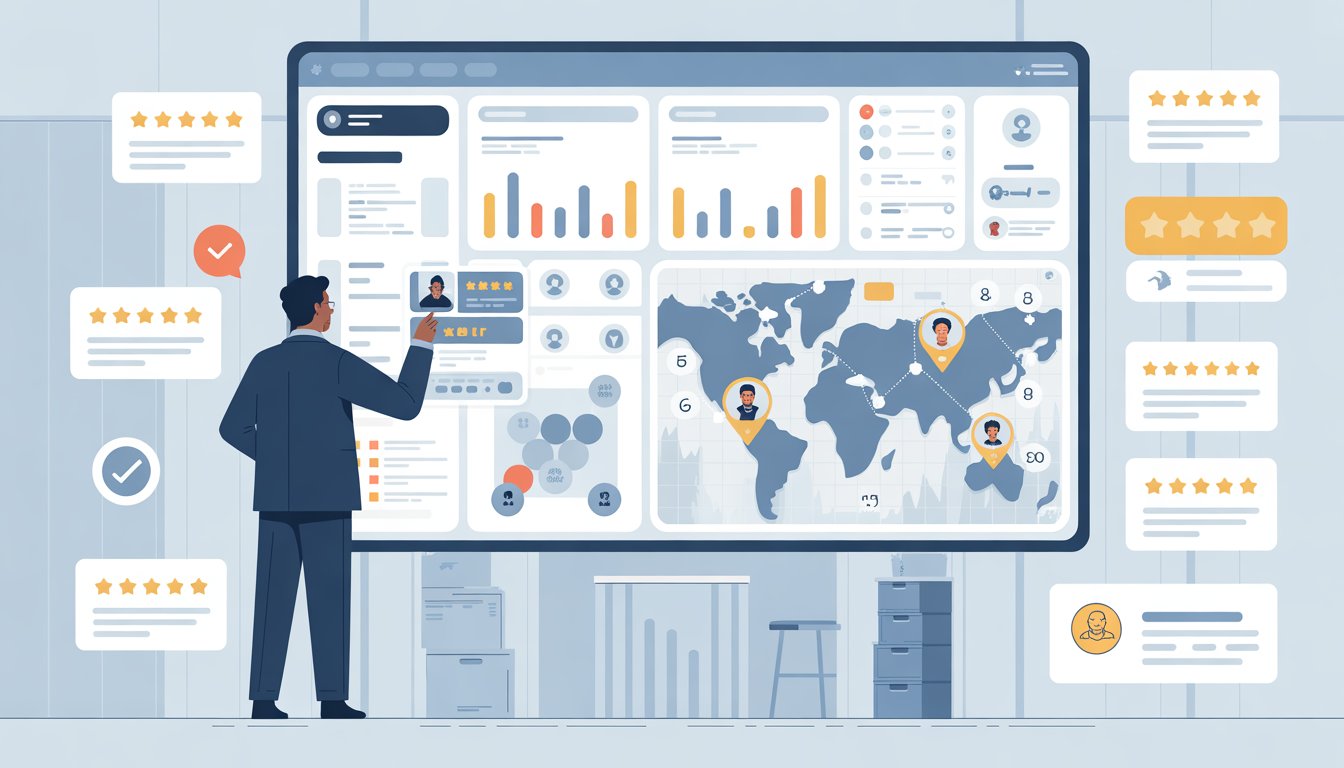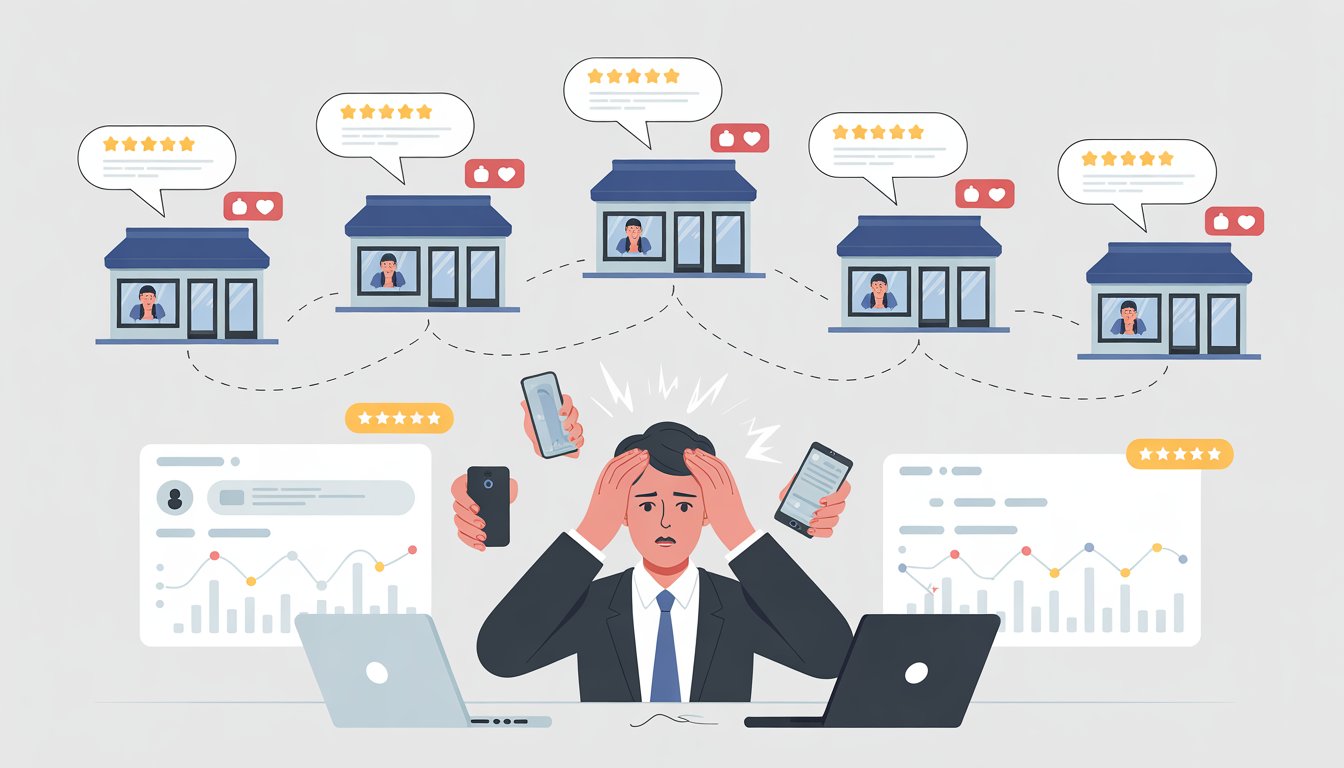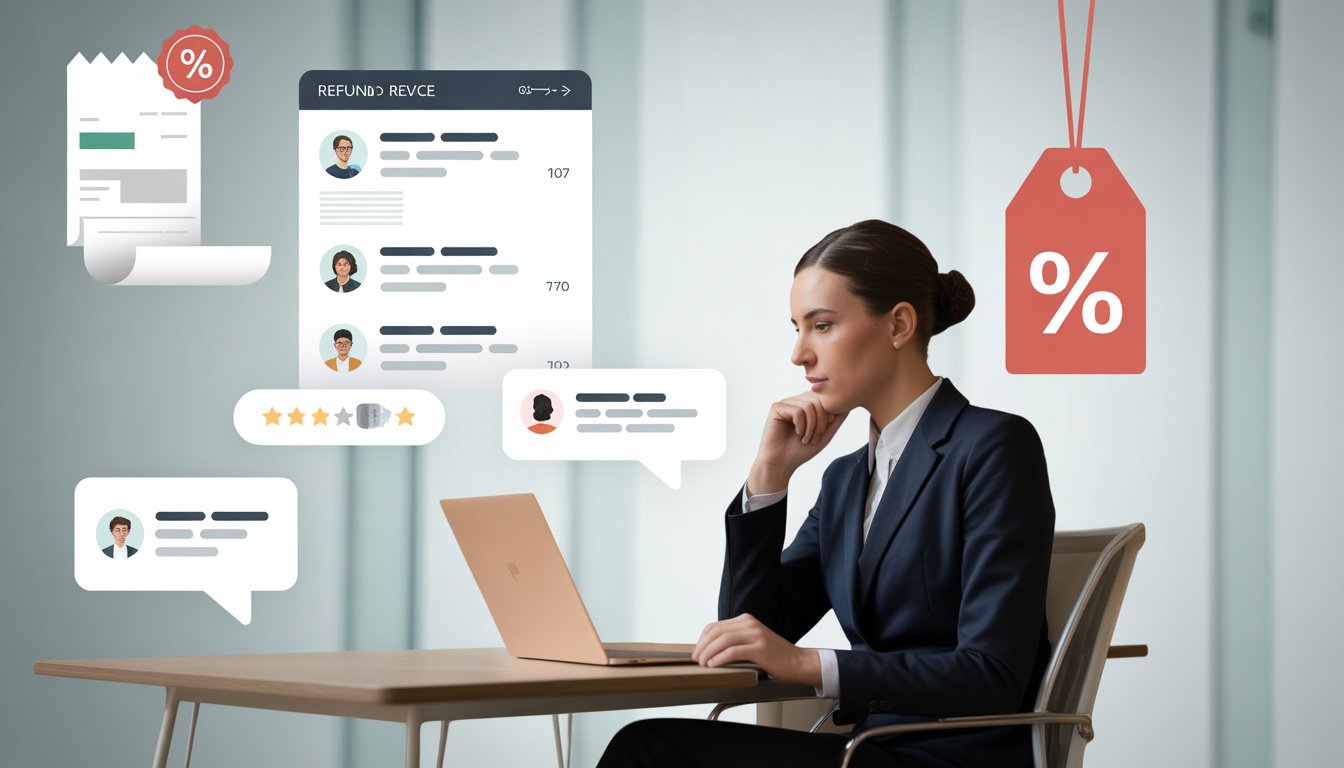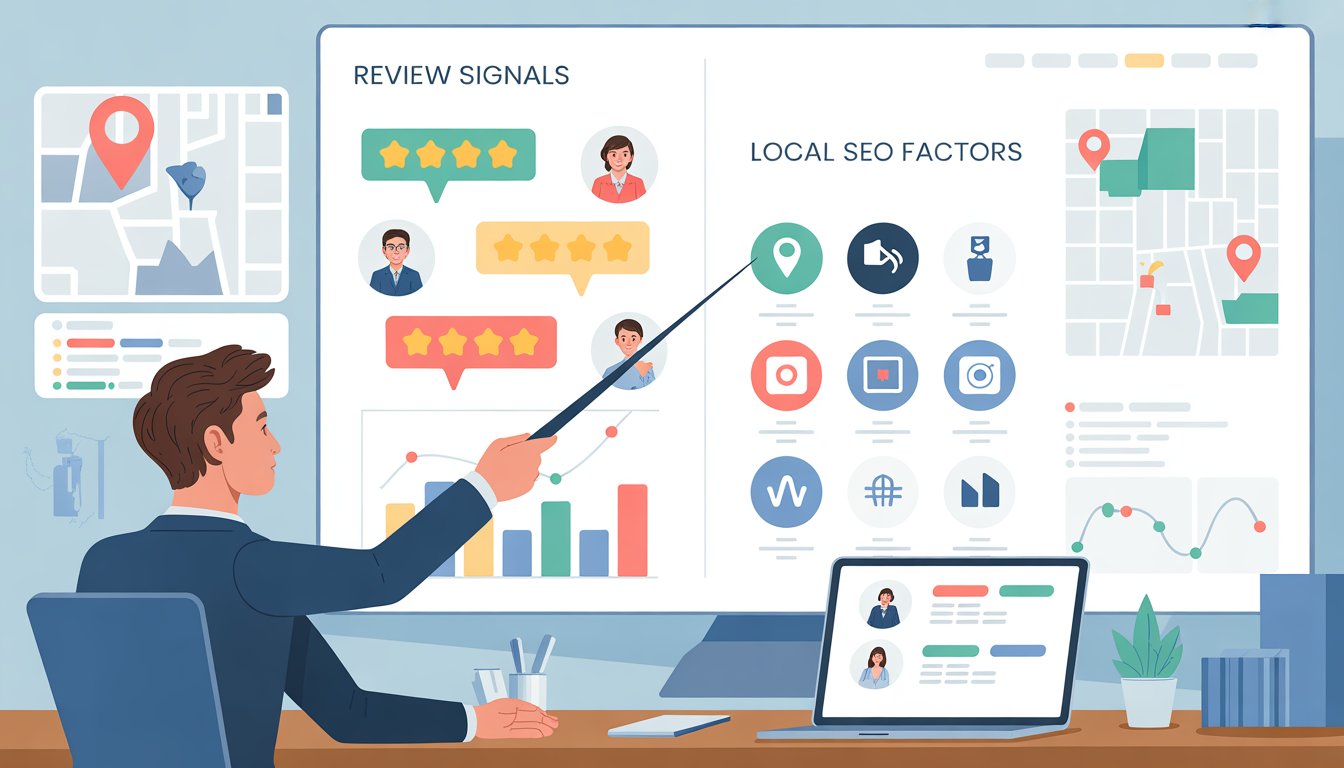Most small businesses start handling reviews manually, checking different sites and responding to customers one by one. This approach works fine when you're just starting out with a few reviews here and there.
But as your business grows and reviews pile up across Google, Facebook, and other platforms, the manual process quickly becomes overwhelming.

You can handle reviews manually when you're small, but review management software becomes essential as your business grows and review volume increases. The real question isn't whether you need it right now, but when manual management will start costing you more time and missed opportunities than the software would cost you.
The difference between manual and automated review management goes beyond just saving time. Software can help you catch negative reviews faster, request reviews from happy customers automatically, and track your reputation trends over time.
These capabilities become nearly impossible to manage manually when you're dealing with dozens or hundreds of reviews each month.
Key Takeaways
- Manual review management works for small businesses but becomes overwhelming as review volume increases
- Review management software saves time and helps catch issues faster than manual monitoring
- The right software provides automated features that are impossible to replicate manually at scale
Why Review Management Matters for Businesses

Customer reviews directly impact your brand's success through trust building and search visibility. Reviews influence how customers find and choose your business online.
The Role of Customer Reviews in Brand Success
Customer reviews serve as powerful social proof that drives brand reputation and customer loyalty. When potential customers see positive feedback from real buyers, they feel more confident about choosing your business.
Reviews build credibility faster than traditional marketing methods. A business with hundreds of positive reviews appears more trustworthy than one with few or no reviews.
Your brand awareness grows when customers leave detailed reviews. These reviews often mention specific products or services, helping other customers understand what you offer.
Customer loyalty increases when you respond to reviews professionally. Customers appreciate businesses that take time to acknowledge their feedback and address concerns.
Reviews also provide valuable insights into what customers love about your business. You can use this information to improve your products and highlight your strengths in marketing materials.
Impact on Customer Trust and Decision-Making
Online reviews directly influence customer purchasing decisions. Over 50% of consumers trust online reviews as much as personal recommendations from friends and family.
Trust develops quickly when customers see recent, authentic reviews. Fresh reviews show that your business actively serves customers and maintains quality standards.
Customers often read reviews before visiting your store or website. Positive reviews can convince hesitant buyers to choose your business over competitors.
Conversion rates improve significantly for businesses with strong review profiles. Customers who read positive reviews are more likely to make purchases and spend more money.
Negative reviews, when handled properly, can actually build trust. Professional responses to complaints show that you care about customer satisfaction and will fix problems.
Influence on SEO and Local Search Visibility
Customer reviews boost your SEO performance and help you rank higher in search results. Search engines view reviews as fresh, relevant content that improves your website's authority.
Local search rankings depend heavily on review quantity and quality. Google considers reviews as a major factor when showing local business results.
Reviews often contain keywords that customers use when searching for businesses like yours. This natural keyword inclusion helps your business appear in more relevant searches.
Your Google My Business listing becomes more visible with regular reviews. Businesses with more reviews typically appear higher in local map results and attract more clicks.
Star ratings display in search results make your business stand out from competitors. Higher ratings can increase click-through rates even when you're not ranked first.
Manual Review Management: Capabilities and Limitations
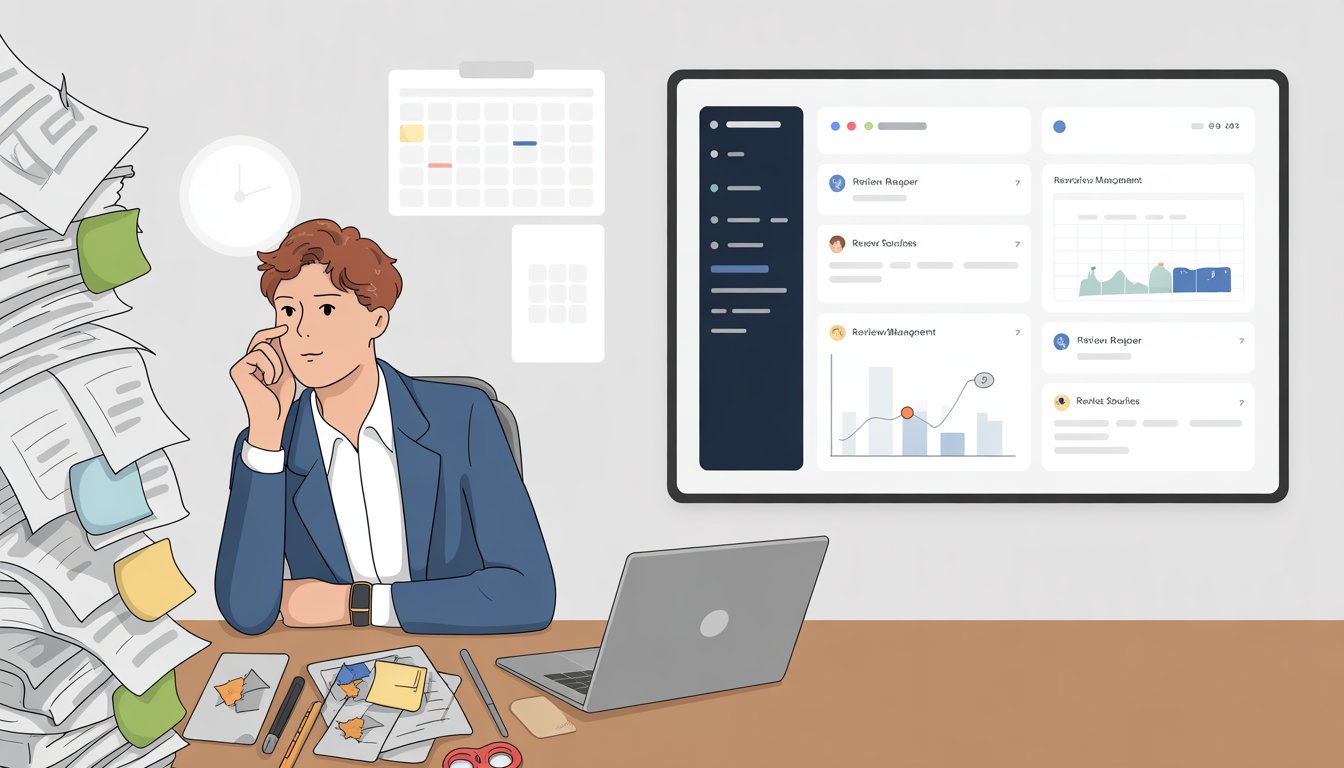
Manual review management requires significant time investment and can become overwhelming as your business grows across multiple platforms. The process involves constant monitoring of sites like Google, Yelp, and TripAdvisor, plus crafting individual responses to maintain consistency.
Time Commitments and Resource Demands
Managing reviews manually takes 2-4 hours daily for most small businesses. You need to check Google Reviews, Yelp, TripAdvisor, and industry-specific platforms every day.
Daily tasks include:
- Checking each review platform separately
- Reading new reviews and rating changes
- Writing personalized responses
- Tracking review trends and patterns
- Following up on negative feedback
A single location business might handle this workload. But companies with multiple locations face exponential time increases.
Each additional location can triple your daily review management time. Staff costs add up quickly when you assign review monitoring to employees.
A dedicated team member spending 20 hours weekly on reviews costs $15,000-25,000 annually in wages and benefits.
Challenges in Monitoring Multiple Review Platforms
Your customers leave reviews on dozens of platforms beyond Google and Yelp. Zomato serves restaurants while TripAdvisor covers hospitality businesses.
Online forums and social media also contain important feedback.
Common monitoring challenges:
PlatformCheck FrequencyResponse Time ExpectedGoogle ReviewsDaily24-48 hoursYelpEvery 2 days48 hoursTripAdvisorWeekly72 hoursIndustry ForumsWeeklyVaries
Missing reviews happens frequently with manual monitoring. You might check Google Business Profile twice daily but miss a negative Yelp review for three days.
Different platforms have unique response systems and formatting rules. Yelp responses work differently than Google Reviews.
TripAdvisor has specific guidelines that differ from Zomato.
Risks of Inconsistent Response Management
Manual response writing creates tone and quality variations across platforms. Your Google Reviews responses might sound professional while Yelp responses seem casual or rushed.
Consistency problems include:
- Different response lengths and detail levels
- Varying apology language for complaints
- Inconsistent company information or offers
- Mixed professional and personal writing styles
Response delays hurt your reputation significantly. Customers expect replies within 24-48 hours on most platforms.
Manual monitoring often leads to 3-5 day delays, especially on weekends. You risk missing critical feedback patterns when handling reviews manually.
A series of complaints about slow service might get individual responses without recognizing the broader operational issue. Human error increases with manual management.
You might accidentally respond to the wrong review or send inappropriate template responses to specific customer complaints.
Review Management Software: Key Features and Advantages
Review management software offers three main benefits that make it worth considering over manual methods. These tools automate time-consuming tasks, provide complete oversight of your online reputation, and deliver detailed insights about customer feedback.
Automation for Efficient Review Collection and Responses
Review management software handles repetitive tasks that eat up your time. You can set up automated invites to collect reviews from customers after they make a purchase or use your service.
Automated Response Features:
- Pre-written templates for common review types
- AI-powered response suggestions
- Scheduled follow-ups for unhappy customers
- Bulk responses for similar feedback
The software can send review requests through email or text at the right time. This timing matters because customers are more likely to leave reviews when their experience is fresh in their mind.
Response automation helps you reply faster. Tools like BrightLocal and others listed on Capterra let you create templates for thank-you messages and problem-solving responses.
You can still personalize these messages while saving hours each week. Some platforms even use AI to suggest responses based on the review content.
This means you never miss responding to feedback, which research shows makes customers 97% more likely to buy again.
Comprehensive Review Monitoring and Alerts
Manual tracking means checking multiple websites every day. Review management software watches all your review sites at once and sends you automated alerts when new feedback appears.
Key Monitoring Features:
- Real-time notifications for new reviews
- Multi-platform tracking (Google, Facebook, Yelp, industry sites)
- Competitor review monitoring
- Keyword alerts for brand mentions
You get instant alerts when someone leaves a review on any platform. This speed matters most for negative reviews because quick responses can turn unhappy customers into loyal ones.
The software tracks reviews across dozens of sites you might forget to check. It also monitors social media mentions and industry-specific review platforms that relate to your business.
Many tools let you track competitor reviews too. This helps you see what customers like about other businesses in your area.
Advanced Reporting and Sentiment Analysis
Review management software turns your feedback into useful data. Instead of reading through hundreds of reviews manually, you get charts and reports that show trends and patterns.
Analytics Features:
- Sentiment scoring for positive/negative trends
- Review volume tracking over time
- Common keyword identification
- Rating breakdowns by location or product
Sentiment analysis uses technology to determine if reviews are positive, negative, or neutral. You can see if your reputation is improving or declining without reading every single review.
The reports show which products or services get the most complaints. This helps you fix problems before they hurt your business.
You also see which aspects customers love most, so you can highlight these strengths in your marketing. Many platforms, including those reviewed on Nextiva and other business software sites, provide customizable dashboards.
You can track the metrics that matter most to your specific business goals.
Comparing Manual Efforts Versus Using Review Management Tools
Manual review management becomes difficult when your business grows bigger or gets more reviews. Review management tools help you stay consistent and spot fake reviews better than doing everything by hand.
Scalability and Consistency of Processes
Manual review management works fine when you get just a few reviews each week. You can read each one and write personal responses without much trouble.
But this approach breaks down fast as your business grows. Managing hundreds of reviews across Google, Yelp, Facebook, and other sites takes hours each day.
Review management tools solve this problem by bringing all your reviews into one place. You can see everything at once instead of checking multiple websites.
These tools also help you respond faster. Many include template responses that you can customize quickly.
This keeps your review strategy consistent even when different team members handle responses. Manual processes often lead to missed reviews or delayed responses.
Some reviews might get long, detailed answers while others get ignored completely. Automated tools send alerts when new reviews come in.
This means you never miss feedback, even during busy periods or when staff is out sick. Your brand image stays stronger when customers get quick, consistent responses to their feedback.
Quality Control and Fake Reviews Detection
Spotting fake reviews manually requires a lot of time and experience. You need to check reviewer profiles, look for strange patterns, and analyze writing styles.
Review management software uses AI to flag suspicious reviews automatically. These tools can spot fake reviews by checking things like:
- Reviewer account history
- Similar wording across multiple reviews
- Unusual posting patterns
- Geographic data inconsistencies
Manual detection often misses sophisticated fake review campaigns. A person might catch obvious fakes but miss subtle ones that tools would find.
Quality control becomes harder to maintain manually as review volume increases. You might respond to fake negative reviews while missing real customer concerns that need attention.
Review management tools also track your response quality over time. They show metrics like response time and customer satisfaction with your replies.
This data helps you improve your review management strategy. Manual tracking of these metrics would take extra time that most business owners don't have.
Reputation and Growth Benefits of Effective Review Management
Review management directly impacts your business growth through improved customer relationships and stronger brand reputation. Smart review handling turns customer feedback into powerful marketing tools while building lasting customer loyalty.
Building Customer Loyalty and Advocacy
Responding to reviews shows customers you value their feedback. This simple action builds trust and encourages repeat business.
When you reply to positive reviews, customers feel appreciated. They are more likely to recommend your business to friends and family.
Personal responses create emotional connections that generic thank-you messages cannot match. Consistent review engagement demonstrates your commitment to customer satisfaction.
Customers notice when businesses care about their opinions. Studies show that businesses responding to reviews see higher customer retention rates.
Your existing customers become your best advocates when they feel heard and valued. Active review management turns one-time buyers into loyal customers.
These loyal customers often leave more positive reviews, creating a cycle of growth.
Leveraging Positive Reviews for Marketing
Positive reviews serve as powerful testimonials for your marketing campaigns. You can use customer feedback across multiple platforms to attract new customers.
User-generated content from reviews costs nothing but delivers high value. Real customer experiences are more convincing than traditional advertising.
Display positive reviews on your website, social media, and marketing materials. These authentic testimonials influence purchasing decisions more than company-created content.
Feature specific review quotes that highlight your business strengths. Choose testimonials that address common customer concerns or showcase unique benefits.
Customer feedback provides fresh marketing content regularly. You gain new promotional material without creating it yourself, saving time and resources.
Managing Negative Reviews to Improve Service
Negative reviews offer valuable insights into your customer experience gaps. Each complaint reveals opportunities to improve your products or services.
Quick responses to negative feedback show you take customer concerns seriously. This often convinces upset customers to give your business another chance.
Address specific issues mentioned in negative reviews. Other potential customers will see you handle problems professionally and work toward solutions.
Use negative feedback to identify recurring problems in your business operations. Pattern recognition helps you fix issues before they affect more customers.
Best Practices for Selecting and Implementing Review Management Solutions
Success with review management software depends on three key factors: matching tools to your specific business goals, connecting them smoothly with your current systems, and creating automated processes that continuously improve your online reputation.
Aligning Tools with Business Needs and Goals
Start by defining your specific review management goals before choosing software. Do you need to increase positive reviews, respond faster to negative feedback, or improve your overall rating?
Different tools excel at different tasks. Consider these key factors:
- Business size: Small businesses may need basic monitoring and response features, while multi-location companies require advanced analytics and centralized dashboards
- Industry requirements: Healthcare businesses need HIPAA compliance, while restaurants might prioritize integration with reservation systems
- Budget constraints: Calculate potential ROI by estimating how improved online reputation could increase customer acquisition
Review your current review volume across major review sites like Google, Yelp, and Facebook. If you receive fewer than 10 reviews monthly, manual management might work.
Higher volumes typically require automated review management tools. Look for software that tracks metrics important to your business.
Response time, sentiment analysis, and competitor benchmarking help measure progress toward your goals.
Integrating with Existing Platforms and Workflows
Choose review management tools that connect with your current business systems. Poor integration creates extra work and reduces efficiency.
Essential integrations include:
System TypeBenefitsCRM platformsAutomatically request reviews from satisfied customersPOS systemsTrigger review requests after purchasesEmail marketingInclude review widgets in newslettersSocial mediaShare positive reviews across platforms
Test the software's API capabilities if you use custom systems. Many review management tools offer pre-built integrations with popular platforms like Salesforce, Shopify, and WordPress.
Train your team on new workflows before full implementation. Staff should understand how to use automated response management features while maintaining your brand voice.
Set up proper user permissions so the right people can access review data and respond appropriately. Location managers might handle individual responses while corporate teams focus on strategy.
Setting Up an Automated Feedback Loop
Create systems that automatically collect, analyze, and act on customer feedback. A strong feedback loop improves your online presence without constant manual oversight.
Configure automated review requests to send at optimal times. For restaurants, this might be 2-3 hours after dining.
For service businesses, wait 24-48 hours after project completion. Key automation features to implement:
- Smart review routing: Send satisfied customers to public review sites, unhappy customers to private feedback forms
- Alert systems: Get notified immediately about negative reviews requiring urgent attention
- Response templates: Use AI-powered suggestions that maintain consistency across all review sites
Set up regular reporting to track your progress. Weekly reports should show new reviews, response rates, and average ratings.
Monthly reports can include competitor comparisons and trend analysis. Monitor your automated systems regularly.
Check that review requests are sending properly and responses match your brand standards. Adjust timing and messaging based on response rates and customer feedback.
Frequently Asked Questions
Business owners often have specific questions about review management software costs, features, and effectiveness. These answers help you make informed decisions about your online reputation strategy.
What are the benefits of using review management software over manual methods?
Review management software saves you significant time by combining all your customer interactions into one platform. You can handle reviews, messages, and feedback from multiple sites without switching between different systems.
Manual management means checking each review site separately. This takes hours each week and makes it easy to miss important feedback.
Software helps you respond faster to reviews. Quick responses build trust with potential customers who see you care about feedback.
The tools also track your progress automatically. You get data on review trends and competitor comparisons without manual research.
How does a review management system streamline handling customer feedback?
A unified inbox collects all reviews from Google, Facebook, and other platforms in one place. You see everything without logging into multiple accounts.
The software sends automatic review requests to customers after purchases. This increases your review volume without extra work from your team.
Templates help you respond to common review types quickly. You can personalize responses while maintaining consistency.
Filtering tools organize reviews by rating, platform, or keywords. You can prioritize negative reviews that need immediate attention.
Can effective online reputation management impact business growth?
Over 80% of consumers trust online reviews as much as personal recommendations. Good review management directly affects your customer acquisition.
Positive reviews improve your local search rankings. Google sees businesses with many good reviews as quality resources for their communities.
Active review management helps you identify service problems early. You can fix issues before they hurt your reputation or drive away customers.
Businesses with strong online reputations charge higher prices. Customers pay more for services they trust based on reviews.
What features should I look for when choosing the best review management software?
Multi-channel collection pulls reviews from all major platforms automatically. This saves time and ensures you never miss feedback.
A clean dashboard displays important information on your main page. You can quickly see new reviews, response rates, and overall ratings.
Analytics tools show trends in your reviews over time. You can track improvements and compare your performance to competitors.
Response management lets you reply to reviews directly from the software. Templates speed up responses while maintaining a personal touch.
Review request capabilities should include text messaging and email options. Automated requests after purchases increase your review volume.
Are there affordable options for reputation management for small businesses?
Many review management platforms offer tiered pricing based on business size. Small businesses can start with basic plans that cost less than hiring extra staff.
The time savings often pay for the software cost. You avoid spending hours each week manually checking review sites.
Some platforms include additional features like appointment scheduling and customer messaging. This adds value beyond just review management.
Free trials let you test software before committing. You can see if the time savings and features justify the monthly cost.
What are the risks of not actively managing online reviews and reputation?
Negative reviews without responses make you look unresponsive to customer concerns. Potential customers assume you don't care about service quality.
Missing reviews means lost opportunities for improvement. Customer feedback helps you identify problems and fix them quickly.
Competitors with better review management will outrank you in search results. Google favors businesses that actively engage with customers online.
Bad reviews spread faster than good ones without proper management. One unaddressed complaint can damage relationships with multiple potential customers.



